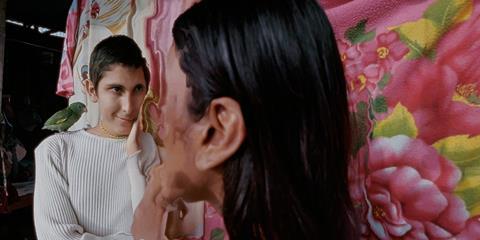Eduardo Williams experimental hybrid looks at the lives of possibly connected young people in Sri Lanka, Taiwan and Peru

Dir/ccr: Eduardo Williams. Argentina/Brazil/Hong Kong/Netherlands/Peru/Portugal/Sri Lanka/Taiwan. 2023. 121mins
“Some explosions occur slowly,” a character observes in Eduardo Williams’ remarkable second feature The Human Surge 3 . It is a film in which, over two hours, the maverick Argentinian virtuoso quietly blows up and rebuilds the established language of cinema in challenging but ultimately exhilarating ways.
Quietly blows up and rebuilds the established language of cinema
The film’s North American bow in Toronto’s Wavelengths sidebar comes after a world premiere at Locarno, seven years after Williams’ The Human Surge won top honours in the Swiss event’s Filmmakers of the Present section. This is a bracing work of freewheeling aesthetic and geographical exploration. Cutting-edge VR technology is placed at the service of a distinctive poetic/artistic sensibility; the results, for all their rough edges and occasional longueurs, offer hints of what the medium might become in the near future.
In a career mainly comprising formally adventurous, award-winning shorts — including Could See a Puma (2011), That I’m Falling? (2013) and Parsi (2019) — Williams has amassed a cult following in film, plus a measure of art-world renown. This latest picture should widen his fanbase: an immersive experience that is worthy of the biggest screens, the globe-spanning co-production is guaranteed further festival play and maybe even theatrical release in receptive markets.
Confusingly, there is (so far) no Human Surge 2. But the title is actually apt, as the new work represents at least two leaps forward in terms of ambition and achievement. The Human Surge abruptly segued between discrete episodes in William’s homeland, Mozambique, and the Philippines to spy on individuals related only by their youth, internet-fixation and financial impoverishment. In retrospect, it now appears like an elaborate sketch for this more fully-realised enterprise, which is certainly more coherent and limpid in cinematographic terms, shot (in collaboration with cinematographer Victoria Pereda) using an 11-lens VR camera. The process of rendering 360-degree footage into two dimensions imparts a fish-eye feel of variable intensity and some occasional weird glitches of mid-image blurring. But these offbeat touches prove much more ornament than distraction.
The tripartite focus remains, The Human Surge 3 moving freely between locations: coastal Sri Lanka dominates the early stretches, urban Taiwan the middle, rural Peru the latter. In each zone, Williams is attracted to ominous skies and inclement weather. As usual, he foregoes traditional notions of plot and character — audiences unwilling to simply go with his idiosyncratic, instinctive flow will soon encounter problems. And while there are signs that much of what we see and hear is at least partly scripted, Williams also disregards categories of fiction and documentary; the boundaries are blurred and effaced.
We frequently observe characters in blissfully dormant states, and Williams’ own editing implies they are somehow connected to their overseas counterparts on subconscious levels. One bunch of earthlings dreams the other; Williams thus challenges Apichatpong Weerasethakul’s long-standing status as cinema’s number one slumber-supremo. During their waking hours, Williams follows small groups as they hang out or wander around, eavesdropping on their elliptical chat. Certain themes pointedly recur in the dialogue, including the grim exigences of 21st-century work and the perfidy of the ultra-wealthy: “Mega-millionaires” are denounced as “perverse, evil, sceptic, sick… The problem is that everyone wants to have that disease.”
The planet depicted is horribly beset with interconnected malaises, including grotesque wealth-inequalities, pervasive anomie, and hazardous air-pollutiom. Williams’ tone is nevertheless surprisingly upbeat, finding joy and even transcendence in the apparently mundane. His rendering of outdoor areas at his preferred “magic hour” of late dusk are especially atmospheric and alluring.
The Human Surge 3’s climactic sequence is the most spectacular, featuring some special-effects that tiptoe into sci-fi realms. Seven characters walk and talk as they ascend a small mountain in Peru, the 360/VR image distorting wildly and trippily as they ascend. Williams, who tried this VR-to-2D approach in 23-minute Parsi, isn’t the first to deploy such distorting techniques: Paul Schrader’s The Card Counter sparingly used similar trickery to hallucinatory effect. But this is surely their most extended display in a feature-length film, and through Williams’ eyes it feels like we’re truly seeing the world anew.
Production company: Un Puma
International sales: Rediance, info@rediancefilms.com
Producers: Chu-ti Chang, Ico Costa, Jeronimo Quevedo, María Victoria Marotta, Aline Mazzarella, Nahuel Perez Biscayart, Matheus Peçanha, Eduardo Williams, Meng Xie
Cinematography: Victoria Pereda
Editing: Eduardo Williams
Music: Alada
Main cast: Meera Nadarasa, Sharika Navamani, Livia Silvano, Abel Navarro, Ri Ri Yang, Bo-Kai Hsu






![The Brightest SunScreen[Courtesy HKIFF]](https://d1nslcd7m2225b.cloudfront.net/Pictures/274x183/3/5/0/1448350_thebrightestsunscreencourtesyhkiff_312678.jpg)















![The Brightest SunScreen[Courtesy HKIFF]](https://d1nslcd7m2225b.cloudfront.net/Pictures/100x67/3/5/0/1448350_thebrightestsunscreencourtesyhkiff_312678.jpg)

